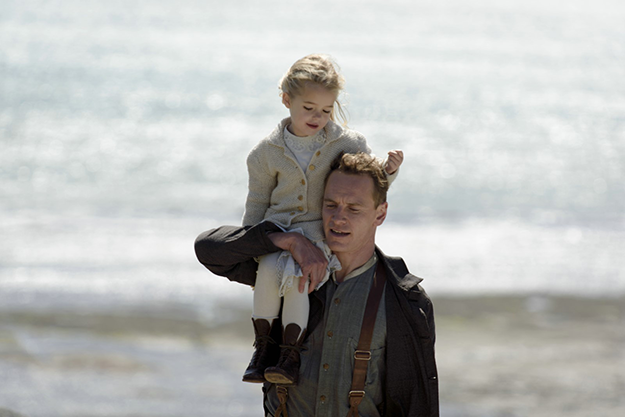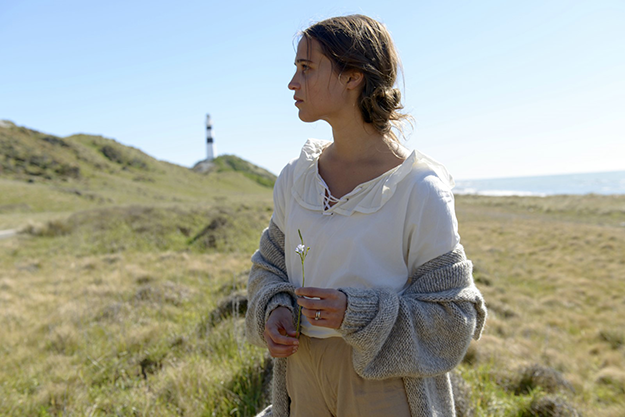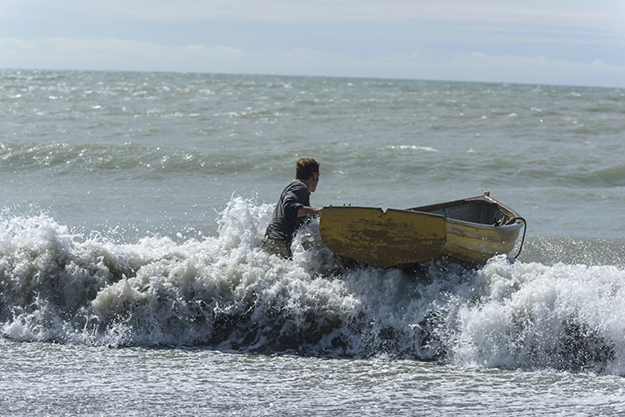Deep Focus: The Light Between Oceans

In the hands of writer-director Derek Cianfrance (Blue Valentine, The Place Beyond the Pines), M.L. Stedman’s engrossing 2013 Thomas Hardy–inspired novel about a World War I veteran who becomes a lightkeeper on Janus Rock, 100 miles off the western coast of Australia, has been transformed into little more than a pious tearjerker.
The title The Light Between Oceans derives from Janus Rock’s location, where the Indian Ocean meets the Great Southern Ocean. And the movie’s luxuriant landscapes and keyed-up performers lull you into early acceptance, before the film reveals its fundamental hollowness. Michael Fassbender makes sensitivity and dignity sexy as Thomas Sherbourne, who survived the trenches with his sanity tested and humanity intact. Alicia Vikander captures youthful rapture in full bloom as Isabel Graysmark, his beautiful local bride, who lives with him in idyllic isolation until she repeatedly miscarries. When a dead man and a still-breathing baby bob up in a dinghy nearby, she thinks Providence has answered her prayers. She persuades Thomas to bury the corpse, destroy the boat, and pretend the baby is hers. It’s a setup worthy of Greek tragedy, but it ends in a high-flown whirlwind of confession and forgiveness.
At the start, Vikander is intoxicating when Isabel realizes she must take the reins of romance with this psychologically wounded man. She even pulls off the potentially embarrassing shot of Isabel exulting in the stark beauty of her little island. Fassbender played, with eerie humor, a robot obsessed with Peter O’Toole’s Lawrence of Arabia in Prometheus. Here his portrait of a rigid man softening for his bride recalls O’Toole’s performance in Goodbye, Mr. Chips. He and Vikander are charming together, especially in the scene when she shaves off his moustache.

Although Cianfrance skillfully evokes love at first sight, he can’t get beyond it persuasively. He makes too many other events happen at close to first sight, including Thomas’s choice to accept Isabel’s plan, then his decision years later to go back on it as soon as he learns that the girl’s biological mother, Hannah Roennfeldt (Rachel Weisz), lives on the mainland and has been pining for her long-lost daughter.
Cianfrance lacks Stedman’s storytelling ability to sweep the characters up in a web of destiny that spans the Western front and Western Australia. Through some deft narrative stitching, Stedman maintains the contrast between the busy town life in Partageuse and the Sherbournes’ cockeyed country existence on Janus Rock. Cianfrance rests that burden almost entirely on the broad shoulders of Ralph Addicott, a sane old salt played by the great Jack Thompson, and his mate, Bluey Smart (Thomas Unger), who keep the lighthouse supplied every three months. But they alone can’t express the loyalties and confusions of townsfolk, who are just one generation removed from the first pioneers.
Cianfrance is so committed to Thomas and Isabel’s perspectives that his movie becomes claustrophobic without ever being particularly revealing (or convincing). Isabel may tell herself that the girl couldn’t have a real live mother and that the man in the dinghy doesn’t deserve a proper funeral. But her scheme is simply selfish and unethical, and Thomas knows it. Stedman puts it more clearly than any scene or line in the movie: “There are weeks at a time when Tom can almost rest in the story of a normal, happy family, as if it is some kind of opiate.” What he faces is less a moral quandary than an existential dilemma.

As a lightkeeper, Thomas has fashioned a rugged, honest existence of labor, order, and service, but Isabel’s life force is what makes him feel alive. He doesn’t want to deny his wife anything, but how can he compromise his integrity? Cianfrance fails to depict Thomas’s heroic stature; he merely illustrates the job Thomas does on Janus Rock rather than dramatize it or testify to its dignity. No matter how lush and magical the locations (actually, New Zealand), The Light Between Oceans turns to visual mush, because it lacks fiber—unlike Stedman’s book, which echoes many great writers besides Hardy, including Herman Melville in his grasp of how the nuts and bolts of a working process can yield character as well as metaphoric gold. Here’s how the author describes igniting a light:
He climbed the tiny metal stairs that led to the inner deck around the light itself, ducked through the opening and into the apparatus of the light. He primed the oil by lighting a flame under its dish so that it vaporized and reached the mantle as a gas. He then set a match to the mantle, which transformed the vapor into a white brilliance. He went down to the next level and started the motor. The light began to turn with the exact, even rhythm of the five-second flash. He picked up the pen, and wrote in the wide, leather-bound log: “Lit up at 5:09 p.m. Wind N/NE 15 knots. Overcast, squally. Sea 6.” Then, he added his initials—T.S.
There’s far more character as well as poetry in that description than in all of Cianfrance’s overwrought inventions. Isabel, in the midst of her first miscarriage, struggles to climb the vertiginous steps from the lightkeeper’s cottage to the lighthouse, during a pounding rainstorm.

The performances suffer from Cianfrance’s tendency to inflate conflicts that lend themselves to silent-movie melodrama while shaving the rough edges off the characters and scanting the book’s legal and marital disputes. Weisz, as the Other Mother, does the movie’s most original, haunting acting. She’s not afraid to make grief both harsh and pathetic, even grating.
It’s as if she gets her personality and edge from the novel, not the script. The book aspires to be about our common mortality, but the movie is a melodrama about mother love gone haywire. Cianfrance reduces even nature’s elements to the elements of melodrama. A furious gale is simply the means to leave Isabel in a near-dead faint at the lighthouse door.
Stedman depicts a downpour drenching Partageuse from the schoolyard to the cemetery, noting, “The rain transforms the living and the dead without preference.” You couldn’t guess from seeing the film that Stedman is capable of paying homage to the transcendent final line of James Joyce’s “The Dead”: “His soul swooned slowly as he heard the snow falling faintly through the universe and faintly falling, like the descent of their last end, upon all the living and the dead.” In the movie, the characters are buried not in rain or snow or earth, but in sentimentality.
Michael Sragow is a contributing editor to FILM COMMENT and writes its Deep Focus column. He is a member of the National Society of Film Critics and the Los Angeles Film Critics Association. He also curates “The Moviegoer” at the Library of America website.



